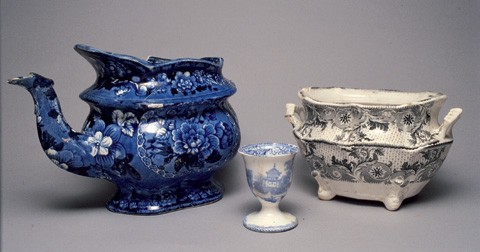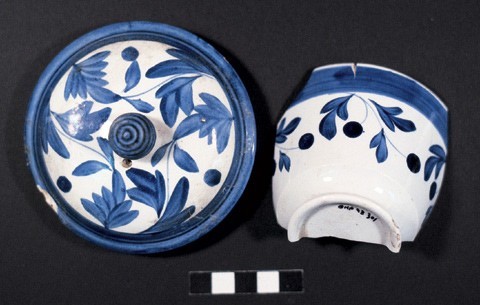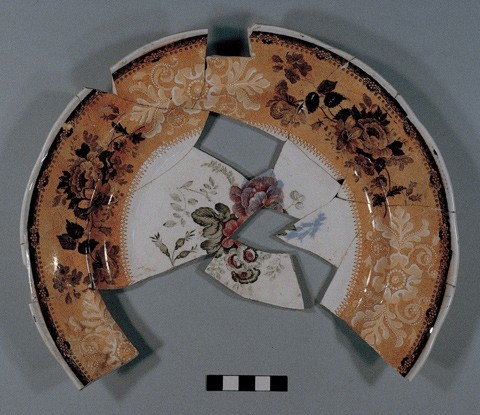
Ceramics recovered from Burslem Market Place excavation: teapot, dark blue printed pattern; egg cup, Sicilian pattern; sugar bowl, Cupid Holding a Tazza to a Swan pattern; Enoch Wood & Sons, Burslem, Staffordshire, ca. 1835. White earthenware. (Courtesy, Potteries Museum & Art Gallery.)

Plate, European Scenery pattern; Enoch Wood & Sons, Burslem, ca. 1835. White earthenware. Scale is in centimeters. (Courtesy, Potteries Museum & Art Gallery.)

Blue-painted cover and cup sherds; attributed to Enoch Wood & Sons, Burslem, ca. 1835. White earthenware. Scale is in centimeters. (Courtesy, Potteries Museum & Art Gallery.)

Polychrome-printed plate; Enoch Wood & Sons, Burslem, ca. 1835. White earthenware. Scale is in centimeters. (Courtesy, Potteries Museum & Art Gallery.)
During excavations on the site of Burslem Market Place in 1998, a large deposit of early-nineteenth-century pottery was recovered. It was quickly recognized as an assemblage of wares made by the well-known factory of Enoch Wood & Sons.
Ceramics recovered from the site include printed wares decorated with a variety of designs: European Scenery, English Cities, Cupid Holding a Tazza to a Swan, Fountain, Venetian Scenery, Pagoda, Oberwessel on the Rhine, and La Fayette at the Tomb of Franklin (fig. 1, 2). The assemblage also contained dark blue-painted tea wares (fig. 3) and polychrome-painted and -printed wares (fig. 4), including previously unidentified printed and painted decorations. Also found were lusterwares; industrial slipwares with mocha, cat’s eye, trailed, cable, and banded decoration; shell-edged and embossed-edged tablewares; and sanitary ware.
Born into a family of potters in 1759, Enoch Wood was an extremely successful pottery manufacturer. He ran his business from the Fountain Place Works in Burslem built in 1789, just a few hundred yards up the road from the excavation site. A substantial potworks, it was described in 1829 as encompassing “the sites of five old factories,”[1] and in the 1830s as employing some thousand workers.
It is believed that the recently discovered Market Place deposit of Wood’s pottery is a cache that was deliberately buried about 1835–1836, prior to the building of a new meat market. Many complete and near-complete pieces were found, some of which seem to have been deliberately placed under upturned toilet bowls, indicating that it was a cache rather than just a pottery dump.
This is not the first known incidence of a cache of Enoch Wood’s wares being unearthed in Burslem. In 1938, a deposit of figures was found in a workman’s trench outside the town hall, and in 1974, a large cache of earthenwares was discovered in the foundations of St. Paul’s Church during its demolition.[2] The St. Paul’s deposit included dark blue-printed wares made specifically for the American market, with scenes of Gilpin’s Mills on the Brandywine Creek and Catskill House, Hudson, as well as those from the French Views series and the English Cities series. Also recovered from the site were painted wares, lusterwares, and figurals.[3]
During construction work in Burslem, Wood regularly recovered old pottery that he then displayed in his factory museum to inspire his workers.[4] This predilection, combined with his keen interest in antiquities, probably led him to bury caches of his ceramics all around town.
Described in 1843 as being employed in the manufacture of earthenware of every variety, Enoch Wood & Sons was reckoned to be among “the largest exporters of that article from Staffordshire to the United States of America.”[5] The factory had commercial links with merchants in the United States. In 1844 to 1845, three businesses, including Enoch Wood, Jr., were listed at 97 Water Street in New York City as conducting the American trade of Enoch Wood & Sons of Burslem.[6]
Catherine Banks
Museum Officer (Archaeology)
The Potteries Museum & Art Gallery
Hanley, Stoke-on-Trent st1 3de
<www.stoke.gov.uk/museums>
Simeon Shaw, History of the Staffordshire Potteries (1829; reprint, Newton Abbot, Devon, England: David & Charles, Ltd. and Wakefield, Yorkshire, Eng.: S. R. Publishers Ltd., 1970), p. 30.
The pottery recovered from these sites is in the ceramics collection at the Potteries Museum & Art Gallery, Stoke-on-Trent.
St. Paul’s Church was built in 1828. It may have been Enoch Wood’s fault that the church had to be later demolished, as it has been suggested that the cache of ceramics buried under the foundations had made the structure unstable.
Miranda F. Goodby, “The Lost Collection of Enoch Wood,” Journal of the Northern Ceramics Society 9 (1992): 123–151.
John Ward, The Borough of Stoke-on-Trent (1843; reprint, Hanley, Stoke-on-Trent, Eng.: Webberley Ltd., 1984), p. 264.
Neil Ewins, “Supplying the Present Wants of our Yankee Cousins, Staffordshire Ceramics and the American Market 1775–1880,” Journal of Ceramic History 15 (1997): 90.
